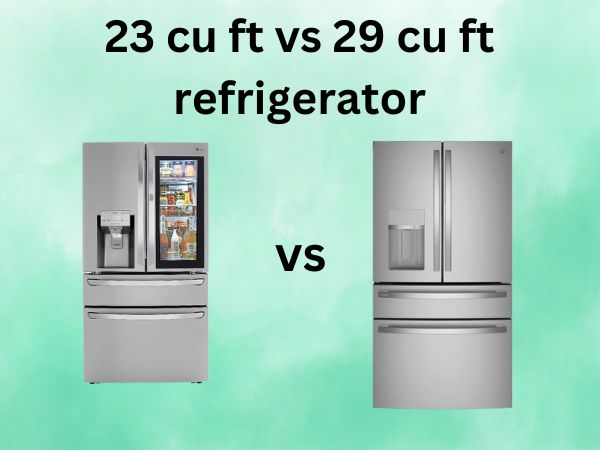23 Cu Ft vs 29 Cu Ft Refrigerator [Which Size Is Right for Your Home?]
Are you standing in an appliance store, scratching your head while staring at two different-sized refrigerators? Or maybe you’re scrolling through online options, cursor hovering between a 23 cu ft and a 29 cu ft model, unsure which one deserves that prime spot in your kitchen? You’re not alone in this refrigerator dilemma!
Choosing between a 23 cubic foot and a 29 cubic foot refrigerator might seem like a simple matter of “bigger is better,” but there’s actually much more to consider. The right choice depends on your specific household needs, kitchen space, lifestyle, and even your shopping habits.
In this comprehensive guide, we’ll break down everything you need to know about these two popular refrigerator sizes, helping you make an informed decision that you won’t regret when that delivery truck pulls away. Let’s dive into the cool world of refrigerator sizing!
Table of Contents
Understanding Refrigerator Sizing Basics
Before we compare our contenders directly, let’s make sure we’re all on the same page about what those cubic foot measurements actually mean.
What Exactly Is Cubic Footage in Refrigerators?
When you see a refrigerator advertised as 23 cu ft or 29 cu ft, that number refers to the total internal storage capacity of the unit. It’s calculated by measuring the interior width, height, and depth of all compartments and then multiplying those dimensions together to get the total volume.
Think of it this way: if you could somehow remove all the shelves, drawers, and compartments and fill your entire refrigerator with tiny one-inch cubes, a 23 cu ft model would hold 23 cubic feet worth of those cubes, while a 29 cu ft model would hold 29 cubic feet worth.
That 6 cubic foot difference between our two contenders might not sound massive on paper, but in practical terms, it’s roughly the equivalent of adding another small refrigerator’s worth of space!
How Manufacturers Measure Refrigerator Space
It’s worth noting that manufacturers measure the total interior space, including every nook and cranny. This includes the space taken up by shelving, ice makers, water dispensers, and other built-in features. The usable space is typically about 80% of the advertised cubic footage.
So when comparing a 23 cu ft to a 29 cu ft refrigerator, remember that the actual usable difference might be closer to 4.8 cubic feet (80% of 6 cu ft). Still substantial, but it helps to have realistic expectations about what that extra space translates to in real life.
Key Differences Between 23 Cu Ft and 29 Cu Ft Refrigerators
Now that we understand what those numbers mean, let’s examine the key differences between these two refrigerator sizes.
Size and Space Requirements
The exterior dimensions can vary significantly between manufacturers, but generally:
- 23 cu ft refrigerators typically measure around 33-36 inches wide, 68-70 inches tall, and 29-34 inches deep
- 29 cu ft refrigerators typically measure around 35-36 inches wide, 68-70 inches tall, and 31-35 inches deep
While the height difference is minimal, the width and especially the depth can increase noticeably with the larger models. Those extra inches might not seem like much until you realize your 29 cu ft fridge sticks out several inches further into your kitchen walkway than you’d anticipated!
Remember that you’ll also need to account for proper ventilation space (typically 1-2 inches) around the sides and back of any refrigerator you choose.
Storage Capacity Comparison
The most obvious difference is storage capacity, but what does this mean in practical terms?
A 23 cu ft refrigerator typically provides:
- Enough space for 2-4 people
- Storage for approximately a week’s worth of groceries for an average family
- Room for some bulk items but limited space for large party platters or holiday food storage
A 29 cu ft refrigerator typically provides:
- Enough space for 5+ people
- Storage for 1-2 weeks of groceries for a larger family
- Ample room for bulk shopping, entertaining supplies, and holiday meal preparation
I once helped my friend Sarah downsize from a 29 cu ft to a 23 cu ft model when she moved to a smaller home. The adjustment was challenging initially—especially since she loved to batch-cook meals for her family of three. She had to reconsider how she organized her food and shopped more frequently, but ultimately found that the 23 cu ft model was sufficient once she adapted.
Energy Consumption Differences
Bigger almost always means more energy consumption when it comes to refrigerators. On average:
- A 23 cu ft ENERGY STAR refrigerator might use around 550-650 kWh per year
- A 29 cu ft ENERGY STAR refrigerator might use around 650-750 kWh per year
This difference can translate to roughly $10-$15 more per year in electricity costs for the larger model (depending on your local rates). Not a massive difference, but over the 10-15 year lifespan of a refrigerator, that adds up to $100-$225 in additional operating costs.
Price Point Variations
The price jump between these two sizes can be substantial:
- 23 cu ft refrigerators typically range from $1,000-$2,500
- 29 cu ft refrigerators typically range from $1,500-$3,500+
That’s a potential difference of $500-$1,000 or more for comparable models with similar features. The question is whether that extra space is worth the additional upfront cost plus the slightly higher energy bills over time.
Is a 23 Cu Ft Refrigerator Right for You?
Let’s look at who might benefit most from choosing the more moderate-sized 23 cu ft refrigerator option.
Ideal Household Sizes for 23 Cu Ft Models
A 23 cubic foot refrigerator is typically ideal for:
- Singles, couples, and small families (2-4 people)
- Empty nesters who no longer need to store food for a full house
- Those who eat out frequently or order takeout often
- People who shop for groceries weekly rather than biweekly or monthly
If this sounds like your household, you’ll likely find that a 23 cu ft model offers plenty of space without wasting energy cooling unused compartments.
Benefits of Choosing a 23 Cu Ft Refrigerator
There are some distinct advantages to going with the smaller option:
Space Efficiency in Smaller Kitchens
If your kitchen has limited square footage, a 23 cu ft refrigerator might be the perfect balance between capacity and space efficiency. The slightly smaller footprint can make a noticeable difference in:
- Kitchen flow and walkway space
- Door clearance (especially important for galley kitchens or island layouts)
- Visual proportion (larger refrigerators can sometimes dominate smaller kitchens)
I have a modestly sized kitchen in my apartment, and when I replaced my old refrigerator, I specifically chose a 23 cu ft model because anything larger would have made the space feel cramped and would have limited my ability to fully open the refrigerator door without hitting my kitchen island.
Cost Savings Considerations
Beyond the initial price difference, choosing the smaller model can save you money in several ways:
- Lower energy bills over time
- Less wasted food (larger refrigerators sometimes lead to forgotten items in the back)
- More reasonable replacement costs for water filters and other accessories
- Potentially lower repair costs (fewer components that could fail)
When to Choose a 29 Cu Ft Refrigerator
Now let’s explore scenarios where the larger 29 cu ft refrigerator makes more sense.
Family Sizes That Benefit from Larger Capacity
A 29 cubic foot refrigerator typically works well for:
- Larger families (5+ members)
- Multigenerational households
- Homes where multiple adults shop and cook separately
- Families with teenagers (who seemingly can never get enough food!)
My neighbor upgraded to a 29 cu ft model when her two sons hit their teenage years, and she says it was the best decision she ever made. “It’s like their appetites doubled overnight,” she told me. “The extra space means I can grocery shop just once a week instead of making multiple trips.”
Advantages of 29 Cu Ft Models
The extra space in a 29 cu ft refrigerator offers several benefits for those who need it:
Entertainment and Bulk Shopping Benefits
If you frequently host gatherings or like to stock up when items go on sale, the larger capacity can be invaluable:
- Space for large party platters and multiple beverage options
- Room for holiday meal preparation (that Thanksgiving turkey plus all the sides)
- Ability to take advantage of bulk purchases and meal prepping
- Fewer grocery shopping trips needed
Storage Configuration Options
Larger refrigerators often come with more specialized storage options:
- Additional deli/meat drawers
- Temperature-controlled zones
- Larger door bins for gallon containers
- Adjustable shelving systems with more configuration possibilities
These features can make organization easier and help preserve different types of foods at their optimal temperatures.
Design and Feature Differences Between Size Classes
Beyond just capacity, there are some key design and feature differences that often distinguish these two size categories.
Door Configurations Available
While both sizes come in various door styles, you’ll find more options in the larger category:
23 cu ft refrigerators typically come in:
- Top freezer models
- Bottom freezer models
- Side-by-side designs
- French door configurations (though with smaller width)
29 cu ft refrigerators are more commonly found as:
- French door models
- Side-by-side designs
- Multi-door configurations (including 4-door and 5-door options)
- Models with extra features like door-in-door access
The larger models are less commonly available in the basic top-freezer design that’s still popular in the 23 cu ft category.
Smart Features Across Size Categories
Interestingly, refrigerator size often correlates with available technology features:
- 23 cu ft models span the range from basic no-frills refrigerators to mid-range smart options
- 29 cu ft models are more frequently equipped with premium features like:
- Wi-Fi connectivity and smartphone apps
- Touchscreens and recipe suggestions
- Interior cameras to check contents remotely
- Voice assistant compatibility
Of course, you can find tech-loaded 23 cu ft models and more basic 29 cu ft options, but manufacturers tend to pack more bells and whistles into their larger flagship models.
Installation Considerations
Before making your final decision, you need to consider some practical aspects of installation.
Measuring Your Space Properly
This cannot be stressed enough: measure, measure, and measure again before committing to either size.
For your refrigerator space, you need to know:
- Width of the opening
- Height from floor to any cabinets above
- Depth from back wall to front edge (including any baseboards)
- Location of nearby counters that might impact door swing
Remember to account for ventilation space requirements—typically 1 inch on the sides and top, plus 2-3 inches at the back.
Doorway and Hallway Clearance Issues
The larger the refrigerator, the more challenging it can be to get it into your home. Consider:
- Width of your front door/entryway
- Any tight hallway turns
- Stairway dimensions (for multi-level homes)
- Doorway height clearances
A 29 cu ft refrigerator might require door removal (both the refrigerator doors and potentially your home’s doors) to navigate through tight spaces. Some consumers have even found they needed to remove door frames or other house fixtures to accommodate their new appliance!
I’ve heard more than one story of a beautiful new refrigerator sitting sadly in a garage because it couldn’t make the turn into the kitchen. Don’t let this happen to you!
Making the Final Decision
With all these factors in mind, how do you ultimately choose between a 23 cu ft and a 29 cu ft refrigerator?
Budget Considerations
Your budget should account for:
- Initial purchase price
- Potential delivery and installation fees (larger units may cost more)
- Expected energy costs over the refrigerator’s lifetime
- Possible kitchen modifications needed for the larger size
If you’re on a tight budget, the 23 cu ft model will almost always be the more economical choice, both upfront and over time.
Long-term Family Planning
Consider your household’s future needs:
- Are you planning to expand your family?
- Will you have adult children moving back home?
- Are elderly parents likely to move in at some point?
- Do you anticipate lifestyle changes that might affect your food storage needs?
If your household is likely to grow in the next 10-15 years (the average lifespan of a refrigerator), investing in the larger 29 cu ft model might save you from needing to replace it prematurely.
Frequently Asked Questions
How much more food can I actually fit in a 29 cu ft refrigerator compared to a 23 cu ft model?
The additional 6 cubic feet translates to roughly 25-30% more storage space. In practical terms, that’s about 4-5 more grocery bags of food, or space for 2-3 large party platters. Many families find this extra space allows them to shop less frequently or accommodate special occasions without needing temporary storage solutions.
Will I notice a significant difference in my electric bill between these two sizes?
While the larger refrigerator does use more electricity, the difference is typically modest—about $10-15 per year for comparable ENERGY STAR models. However, this can vary based on your electricity rates, how frequently the refrigerator is opened, and the ambient temperature of your kitchen. Models with additional features like ice makers and water dispensers will consume slightly more energy regardless of size.
Can I fit either size refrigerator through a standard doorway?
Most standard residential doorways are 30-36 inches wide, which is usually sufficient for both sizes when the refrigerator doors and handles are removed. However, a 29 cu ft model might require more careful maneuvering, especially through tight hallways or corners. Always check the exact dimensions of your chosen model and measure all doorways and pathways before purchase.
Is the price difference between 23 cu ft and 29 cu ft models consistent across all brands?
No, the price gap varies significantly by brand and feature set. While budget brands might have a $300-400 difference between these sizes, premium manufacturers could have a gap of $800-1000 or more. The price difference tends to increase further when comparing models with advanced features like smart connectivity or specialized cooling zones.
If I’m single but entertain frequently, which size should I choose?
For a single person who entertains often, a 23 cu ft refrigerator is generally sufficient unless your gatherings are very large or frequent. Consider a model with flexible storage options, like adjustable shelving or a convertible zone that can change from refrigerator to freezer space as needed. This gives you the versatility for entertaining without the higher costs and space requirements of a 29 cu ft model that might sit partially empty most of the time.
Conclusion
When deciding between a 23 cu ft and a 29 cu ft refrigerator, there’s no one-size-fits-all answer. The right choice depends on your specific needs, space constraints, and budget.
A 23 cu ft refrigerator is perfect for smaller households, tighter kitchen spaces, and more budget-conscious consumers. It offers a good balance between adequate storage and energy efficiency.
A 29 cu ft refrigerator shines for larger families, frequent entertainers, and bulk shoppers. The extra space provides flexibility and convenience that can make daily life easier, albeit at a higher cost both upfront and over time.
Whichever size you choose, make sure to measure carefully and consider both your current and future needs. Remember that the best refrigerator isn’t necessarily the biggest or the most feature-packed—it’s the one that fits your lifestyle, your kitchen, and your budget just right.




